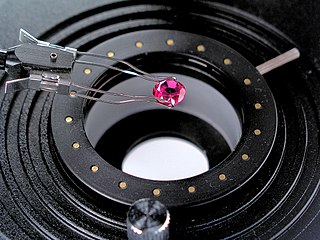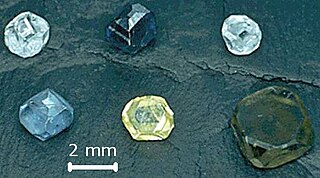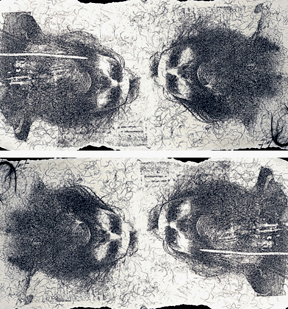
Ash or ashes are the solid remnants of fires. Specifically, ash refers to all non-aqueous, non-gaseous residues that remain after something burns. In analytical chemistry, to analyse the mineral and metal content of chemical samples, ash is the non-gaseous, non-liquid residue after complete combustion.

Diamond is a solid form of the element carbon with its atoms arranged in a crystal structure called diamond cubic. Diamond as a form of carbon is a tasteless, odourless, strong, brittle solid, colourless in pure form, a poor conductor of electricity, and insoluble in water. Another solid form of carbon known as graphite is the chemically stable form of carbon at room temperature and pressure, but diamond is metastable and converts to it at a negligible rate under those conditions. Diamond has the highest hardness and thermal conductivity of any natural material, properties that are used in major industrial applications such as cutting and polishing tools. They are also the reason that diamond anvil cells can subject materials to pressures found deep in the Earth.

A gemstone is a piece of mineral crystal which, when cut or polished, is used to make jewelry or other adornments. Certain rocks and occasionally organic materials that are not minerals may also be used for jewelry and are therefore often considered to be gemstones as well. Most gemstones are hard, but some softer minerals such as brazilianite may be used in jewelry because of their color or luster or other physical properties that have aesthetic value. However, generally speaking, soft minerals are not typically used as gemstones by virtue of their brittleness and lack of durability.

Sapphire is a precious gemstone, a variety of the mineral corundum, consisting of aluminium oxide (α-Al2O3) with trace amounts of elements such as iron, titanium, cobalt, lead, chromium, vanadium, magnesium, boron, and silicon. The name sapphire is derived from the Latin word sapphirus, itself from the Greek word sappheiros (σάπφειρος), which referred to lapis lazuli. It is typically blue, but natural "fancy" sapphires also occur in yellow, purple, orange, and green colors; "parti sapphires" show two or more colors. Red corundum stones also occur, but are called rubies rather than sapphires. Pink-colored corundum may be classified either as ruby or sapphire depending on the locale. Commonly, natural sapphires are cut and polished into gemstones and worn in jewelry. They also may be created synthetically in laboratories for industrial or decorative purposes in large crystal boules. Because of the remarkable hardness of sapphires – 9 on the Mohs scale (the third-hardest mineral, after diamond at 10 and moissanite at 9.5) – sapphires are also used in some non-ornamental applications, such as infrared optical components, high-durability windows, wristwatch crystals and movement bearings, and very thin electronic wafers, which are used as the insulating substrates of special-purpose solid-state electronics such as integrated circuits and GaN-based blue LEDs. Sapphire is the birthstone for September and the gem of the 45th anniversary. A sapphire jubilee occurs after 65 years.

Cubic zirconia (abbreviated CZ) is the cubic crystalline form of zirconium dioxide (ZrO2). The synthesized material is hard and usually colorless, but may be made in a variety of different colors. It should not be confused with zircon, which is a zirconium silicate (ZrSiO4). It is sometimes erroneously called cubic zirconium.

Gemology or gemmology is the science dealing with natural and artificial gemstone materials. It is a specific interdisciplinary branch of mineralogy. Some jewelers are academically trained gemologists and are qualified to identify and evaluate gems.

Cremation is a method of final disposition of a dead body through burning.

Moissanite is naturally occurring silicon carbide and its various crystalline polymorphs. It has the chemical formula SiC and is a rare mineral, discovered by the French chemist Henri Moissan in 1893. Silicon carbide or moissanite is useful for commercial and industrial applications due to its hardness, optical properties and thermal conductivity.
Synthetic things are composed of multiple parts, often with the implication that they are artificial. In particular, 'synthetic' may refer to:

A laboratory-grown diamond (LGD), also called a lab-grown diamond, laboratory-created, man-made, artisan-created, artificial, synthetic, or cultured diamond, is diamond that is produced in a controlled technological process. Unlike diamond simulants, synthetic diamonds are composed of the same material as naturally formed diamonds—pure carbon crystallized in an isotropic 3D form—and share identical chemical and physical properties. As of 2023 the heaviest synthetic diamond ever made weighs 30.18 ct, and the heaviest natural diamond ever found weighs 3167 ct.
Gemesis Inc. was a privately held company located in New York City. The company grew synthetic diamonds using proprietary technology.
Diamond enhancements are specific treatments, performed on natural diamonds, which are designed to improve the visual gemological characteristics of the diamond in one or more ways. These include clarity treatments such as laser drilling to remove black carbon inclusions, fracture filling to make small internal cracks less visible, color irradiation and annealing treatments to make yellow and brown diamonds a vibrant fancy color such as vivid yellow, blue, or pink.

A diamond simulant, diamond imitation or imitation diamond is an object or material with gemological characteristics similar to those of a diamond. Simulants are distinct from synthetic diamonds, which are actual diamonds exhibiting the same material properties as natural diamonds. Enhanced diamonds are also excluded from this definition. A diamond simulant may be artificial, natural, or in some cases a combination thereof. While their material properties depart markedly from those of diamond, simulants have certain desired characteristics—such as dispersion and hardness—which lend themselves to imitation. Trained gemologists with appropriate equipment are able to distinguish natural and synthetic diamonds from all diamond simulants, primarily by visual inspection.

The Gemological Institute of America (GIA) is a nonprofit institute based in Carlsbad, California. It is dedicated to research and education in the field of gemology and the jewelry arts. Founded in 1931, GIA's mission is to protect buyers and sellers of gemstones by setting and maintaining the standards used to evaluate gemstone quality. The institute does so through research, gem identification, diamond grading services, and a variety of educational programs. Through its library and subject experts, GIA acts as a resource of gem and jewelry information for the trade, the public and media outlets.

Alkaline hydrolysis is a process for the disposal of human and pet remains using lye and heat, and is an alternative to burial or cremation.
Gemmological Institute of India is a gemmology training school in Mumbai, India.
Richard T. Liddicoat, Jr. was an American gemologist. An educator in gemology, he contributed in the area of diamond quality grading and gem identification. Liddicoat was the Chairman of the Board of Governors at the Gemological Institute of America (GIA).
WD Lab Grown Diamonds was a manufacturer of synthetic chemical vapor deposition (CVD) diamonds, headquartered in the Washington, D.C. area. Founded in 2008, WD produced lab-grown diamonds for distribution under the brands WD Lab Grown Diamonds and Latitude, in addition to creating diamonds for high-tech Advanced Materials applications. The company formally pivoted and relaunched as WD Advanced Materials, LLC in November 2023.

William G. "Bill" Fink is a California-based American artist known for his technique for producing images of his subject matter by making the photograph itself out of soil, clippings of human hair, pollen, cremation ashes, etc. to simulate photorealistic vintage photographs of the person/ object/ location from which those media originally derived, and the images then printed in a light-sensitive alternative photographic process Fink describes as "Time and Matter Photography". Fink has laid claim to being the originator of the technique of using virtually any material in the place of traditional photo chemicals to create an image, saying, "There are silver prints, gold prints, and platinum prints-- precious from a metal standpoint-- but they embody nothing more than capturing time; ash is a way to capture both time and matter."

Gemological Science International, or GSI, is an independent gemological organization that is one of the largest gemological entities in the world, with offices in four continents.












